Ellu Kozhukattai – Steamed sweet dumplings stuffed with sesame seeds and jaggery mixture offered as prasadam or neivediyam during festivals. Here is my recipe for kozhukattai with store-bought rice flour.
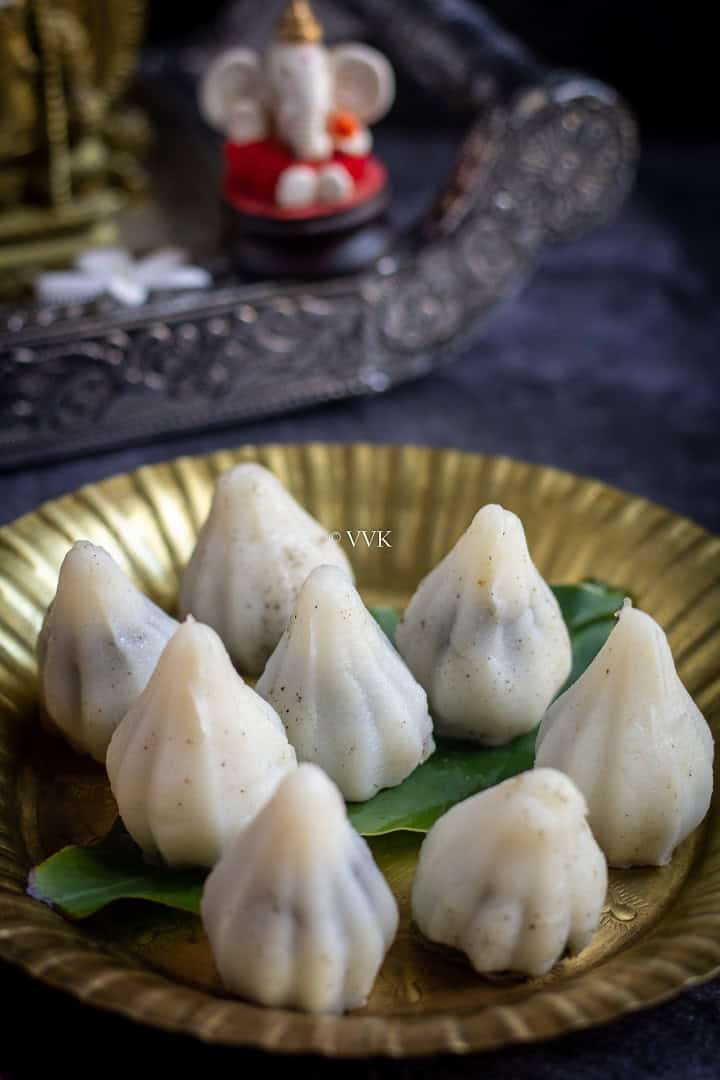
The festival of Vinayaka Chaturthi or Ganesh Chaturthi is right around the corner, and today I am going to share the recipe for ellu kozhukattai or sesame seeds modak.
I have already shared the famous coconut-jaggery modak or thengai poorana kozhukattai on my blog. I had mentioned in that post that we make different varieties of kozhukattai and one such variety is this ellu poorana kozhukattai.
Ellu means sesame seeds in Tamil, and pooranam is the filling mixture; hence the name ellu poorana kozhukattai.
We make kozhukattai for the Varamahalakshmi festival and also for Garuda Panchami. While I don’t make different varieties of kozhukattai for those two festivals, I try to make atleast two varieties for Vinayaka Chaturthi. Mostly it will be the coconut filling one and the sesame filling kozhukattai.
The filling for this kozhukattai is effortless, and I use my chigali/sesame seeds laddu as the filling for this kozhukattai. I did mention it on my chigali post as well.
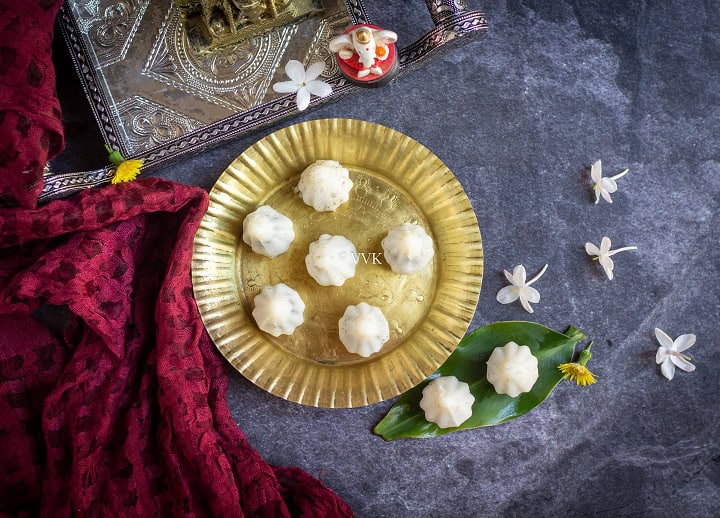
We make sesame seed laddu, and rice flour laddu for all our festivals, and I set aside some sesame seed jaggery mixture for this kozhukattai. This post is the combination of chigali and thengai poorana kozhukattai. :-)
The kozhukattai process might seem lengthy and challenging, but with practice, it becomes easy. Especially if you have molds to shape the kozhukattai, the process is effortless.
You can find modak mold in Indian groceries these days. My friend gifted me this small mold, and I use it for the savory, and this sesame seed kozhukattai.
There are four main steps involved in the kozhukattai-
- We first prepare the filling. You can prepare it well ahead and refrigerate.
- Then we prepare the dough or the outer layer.
- Then comes the shaping and filling process.
- And we steam the stuffed modaks.
Yield & Recipe Measure-
The yield varies depending upon the mold size and how thick your outer covering is. With this measure, you can make 5 to 6 bigger modak and 8 to 10 small ones. The nutrition information is for 10 servings.
You can double or triple the measurement as per your need.
The outer cover is the same for all the kozhukattai varieties. I just prepare the outer cover once. As we like coconut filling one very much, I make more coconut filling ones and 4 to 6 of other varieties.
Don’t worry if you have the extra filling or the outer layer dough. The extra filling always becomes sesame seed laddu. You can add more ghee or oil and shape into laddu. With extra outer dough- you can always make ammini kozhukattai.
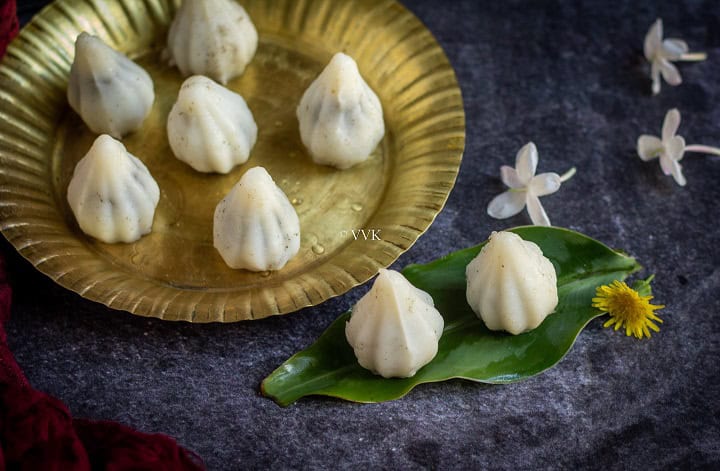
Without any further ado, let’s get straight into the recipe. Please carefully follow the instructions and also check the recipe notes for the perfect modak.
Preparing the filling-
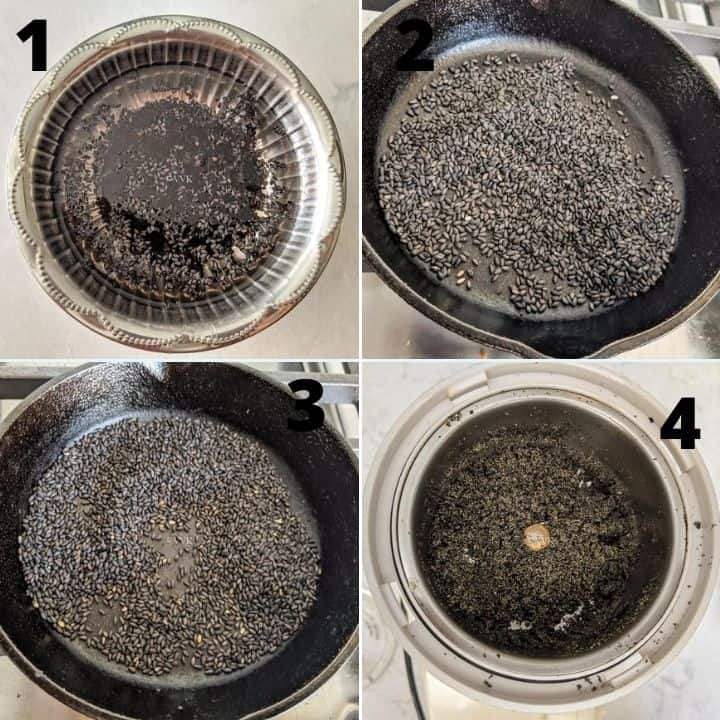
- Soak sesame seeds in water for 20 to 30 minutes.
- Drain the water thoroughly. I usually use my tea strainer and drain the water.
- Now heat a pan and add the drained sesame seeds and dry roast until they splutter and pop out.
- As they start to splutter, turn off the heat and let it cool completely.
- In a mixer jar or coffee grinder, add the jaggery, ground cardamom, and roasted and cooled sesame seeds.
- Grind it until the sesame and jaggery are well combined. You can grind it according to your texture preference. Sometimes I grind smooth and sometimes coarse. Both work well for the kozhukattai.
- Add 2 tsps of ghee or oil and mix well. Ghee adds a rich flavor, but you can skip it for the vegan version. The filling is ready. Now set this aside.
Prepare the outer covering-
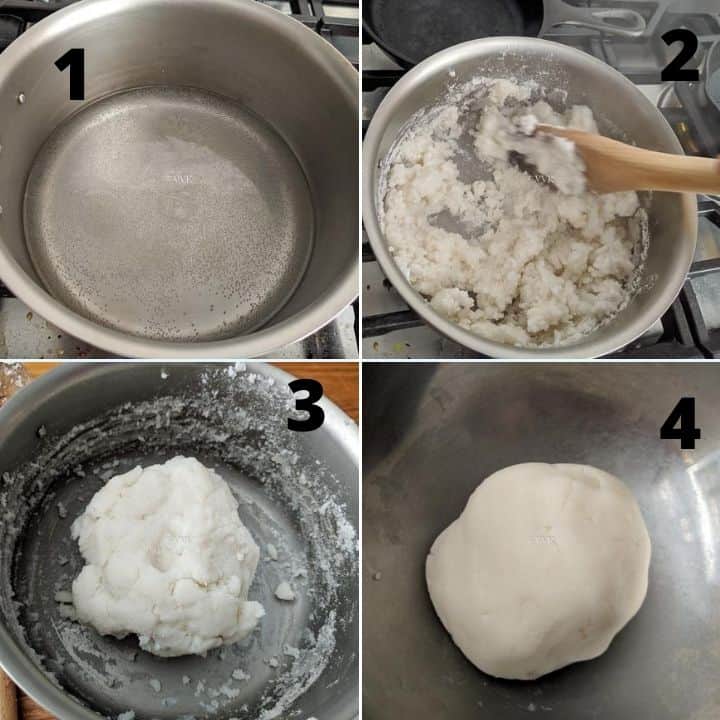
- Bring 1 cup + 2 tbsps of water to a boil in a saucepan. Add the oil or ghee and also the salt.
- When the water starts boiling, reduce the heat to low. Add the rice flour slowly.
- Using the back of the spoon/ladle mix the flour well. It will be crumbly, and that’s fine.
- After mixing, turn off the heat and cover the pan and let it sit for 5 minutes.
- Consistency check – take a small amount of the dough and see if you can shape it into a ball. It should not fall apart. If it’s very crumbly, sprinkle 2 to 3 tbsps of water and cover and cook over low heat for two minutes and turn it off.
- While the dough is warm-enough and easy to handle, wet your palms in cold water and shake off the excess water. Knead it gently and form a crack-free dough.
- Cover it with a damp cloth or tissue. Do not let the dough dry out.
Shaping and filling the kozhukattai-
I always use my small mold for this kozhukattai. For the traditional boat-shaped kozhukattai, please check my thengai poorana kozhukattai post.
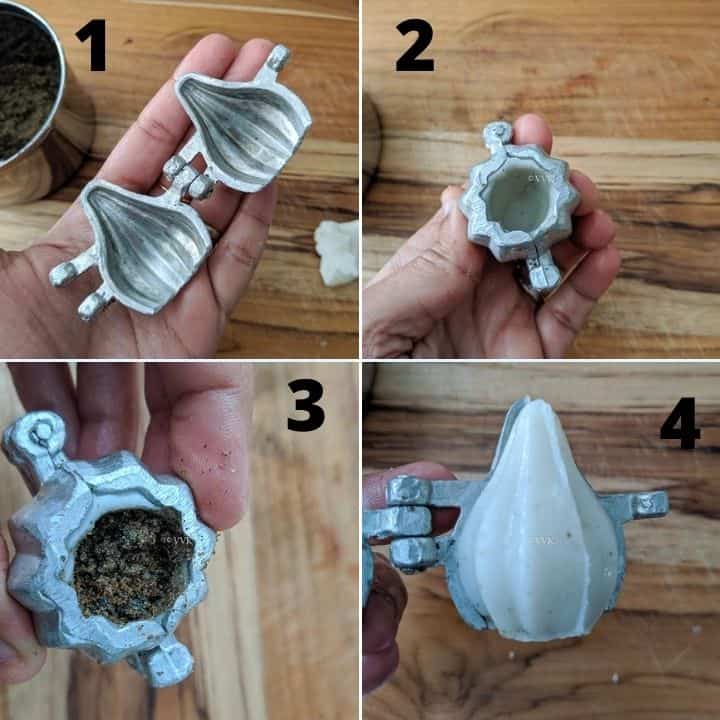
- Grease the inside of the mold with sesame oil. Now close the mold.
- Depending upon the size of the mold, pinch the required amount of dough.
- Place the dough inside the mold and gently spread it along the mold’s sides/wall so that it’s the shape of the mold. Make sure you are spreading it evenly, and there is sufficient space in the center for the filling. Remove the excess dough from the sides.
- Now gently add 1 of the sesame seed filling and stuff it inside. Take a small piece of the dough, press it into a small circle, and seal the mold’s bottom. Now carefully open the mold and remove the modak from the mold and set it aside. Make sure to cover it till you steam.
- Repeat the same process with the remaining dough and the filling.
Steaming the kozhukattai-
- I use my idli cooker and idli plates to steam the modak. The idli cooker adds 1.5 cups of water and brings it to boil while you are shaping and filling the kozhukattai.
- Grease the idli plates with sesame oil and placed the shaped kozhukattai in the idli plate. Depending upon the size of the kozhukattai, you can keep one or two. If the kozhukattais are small, I keep two in one idli plate mold, if not just one. Do not overcrowd the idli plates with kozhukattais. Steam in batches.
- Now steam the kozhukattai over medium heat for 8 to 10 minutes. Then turn off the heat and let it sit for 5 minutes. Then open the idli cooker and remove the kozhukattai.
- Serve warm and enjoy!
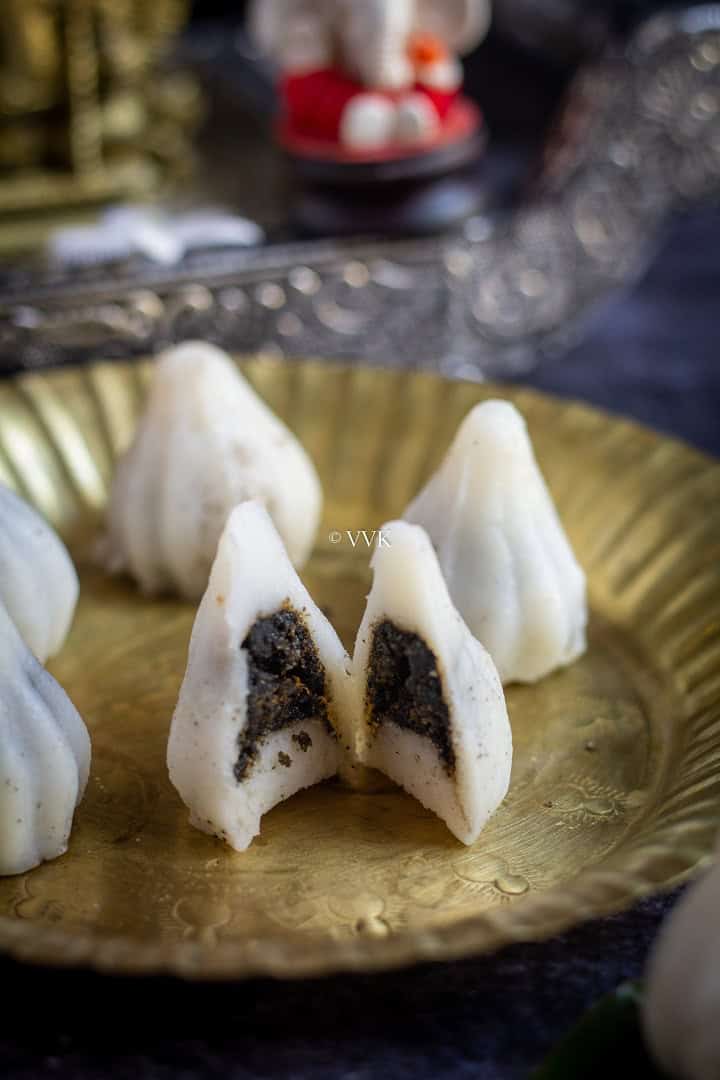
Recipe Notes-
- I highly recommend soaking black sesame seeds as it removes the undigestable acids. And we always use black sesame seeds for the kozhukattai. But you can use white sesame seeds also. In that case, you can skip the soaking part.
- Adjust the jaggery amount according to your preference.
- You can find how to make cardamom powder on my YouTube channel. If you don’t have cardamom powder, you can use one whole green cardamom. Crush it and roast it along with black sesame seeds. You can discard the outer covering and grind it, or you can include the covering as well.
- While preparing the dough for the outer covering, you can add ghee instead of gingelly oil. Also, you can add ½ tsp sugar. I have tried both in several attempts.
- I did not roast my store-bought rice flour. But if you keep your flour in the freezer or fridge, bring it to room temperature. Dry roast it for a couple of minutes and sieve it so that there aren’t any lumps.
- For this particular brand, I had to use 1 cup and an extra 2 tbsps of water. You can also use 1 cup of water for 1 cup of flour. And while kneading, if the flour is dry, add lukewarm water on the needed basis and knead the dough. The water amount varies depending upon the brand.
- I have tried making kozhukattai with both store-bought rice flour and idiyappam flour. Both have come out well.
- Knead the dough while it is warm enough to handle. Don’t let the dough get cold.
- Always cover the outer dough with a damp cloth or tissue. Do not let the dough dry out.
PS: Follow me on Instagram or join my Facebook Group for more gardening and recipe updates. If you try this sesame seeds kozhukattai recipe, please don’t forget to comment and rate this recipe. If you have any questions, please leave a comment, and I will get to it asap. Make sure to follow me on my Pinterest for more healthy and delicious ideas!
📖 Recipe
Ellu Kozhukattai | Sesame Seeds Modak
Equipment
- Saucepan or kadai
- steamer like idli cooker
- Modak mold
Ingredients
Measurement Details: 1 cup=240ml; 1 tbsp=15ml; 1tsp=5ml;
For the filling-
- 2 tbsp black sesame seeds
- ½ cup water to soak the sesame seeds
- 1.5 tbsp jaggery powdered or shaved
- ¼ tsp cardamom ground
- 2 tsp ghee use oil for a vegan version
For the cover:
- 1 cup rice flour I used store-bought rice flour. You can use idiyappam flour also
- 1.25 cup water divided, refer notes.
- 1 tsp gingelly oil
- ¼ tsp salt
Other ingredients-
- 3 tbsps gingelly oil for greasing the mold and steaming plates.
- 1.5 cups water to steam
Instructions
Preparing the filling-
- Soak sesame seeds in water for 20 to 30 minutes.
- Drain the water thoroughly. I usually use my tea strainer and drain the water.
- Now heat a pan and add the drained sesame seeds and dry roast until they splutter and pop out.
- As they start to splutter, turn off the heat and let it cool completely.
- In a mixer jar or coffee grinder, add the jaggery, ground cardamom, and roasted and cooled sesame seeds.
- Grind it until the sesame and jaggery are well combined. You can grind it according to your texture preference. Sometimes I grind smooth and sometimes coarse. Both work well for the kozhukattai.
- Add 2 tsps of ghee or oil and mix well. Ghee adds a rich flavor, but you can skip it for the vegan version. The filling is ready. Now set this aside.
Prepare the outer covering-
- Bring 1 cup + 2 tbsps of water to a boil in a saucepan. Add the oil or ghee and also the salt.
- When the water starts boiling, reduce the heat to low. Add the rice flour slowly.
- Using the back of the spoon/ladle mix the flour well. It will be crumbly, and that's fine.
- After mixing, turn off the heat and cover the pan and let it sit for 5 minutes.
- Consistency check - take a small amount of the dough and see if you can shape it into a ball. It should not fall apart. If it's very crumbly, sprinkle 2 to 3 tbsps of water and cover and cook over low heat for two minutes and turn it off.
- While the dough is warm-enough and easy to handle, wet your palms in cold water and shake off the excess water. Knead it gently and form a crack-free dough.
- Cover it with a damp cloth or tissue. Do not let the dough dry out.
Shaping and filling the kozhukattai-
- I always use my small mold for this kozhukattai. For the traditional boat-shaped kozhukattai, please check my thengai poorana kozhukattai post.
- Grease the inside of the mold with sesame oil. Now close the mold.
- Depending upon the size of the mold, pinch the required amount of dough.
- Place the dough inside the mold and gently spread it along the mold's sides/wall so that it's the shape of the mold. Make sure you are spreading it evenly, and there is sufficient space in the center for the filling. Remove the excess dough from the sides.
- Now gently add 1 of the sesame seed filling and stuff it inside. Take a small piece of the dough, press it into a small circle, and seal the mold's bottom. Now carefully open the mold and remove the modak from the mold and set it aside. Make sure to cover it till you steam.
- Repeat the same process with the remaining dough and the filling.
Steaming the kozhukattai-
- I use my idli cooker and idli plates to steam the modak. The idli cooker adds 1.5 cups of water and brings it to boil while you are shaping and filling the kozhukattai.
- Grease the idli plates with sesame oil and placed the shaped kozhukattai in the idli plate. Depending upon the size, you can keep one or two.
- Now steam the kozhukattai over medium heat for 8 to 10 minutes. Then turn off the heat and let it sit for 5 minutes. Then open the idli cooker and remove the kozhukattai.
- Serve warm and enjoy!
Notes
- I highly recommend soaking black sesame seeds as it removes the undigestable acids. And we always use black sesame seeds for the kozhukattai. But you can use white sesame seeds also. In that case, you can skip the soaking part.
- Adjust the jaggery amount according to your preference.
- You can find how to make cardamom powder on my YouTube channel. If you don't have cardamom powder, you can use one whole green cardamom. Crush it and roast it along with black sesame seeds. You can discard the outer covering and grind it, or you can include the covering as well.
- While preparing the dough for the outer covering, you can add ghee instead of gingelly oil. Also, you can add ½ tsp sugar. I have tried both in several attempts.
- I did not roast my store-bought rice flour. But if you keep your flour in the freezer or fridge, bring it to room temperature. Dry roast it for a couple of minutes and sieve it so that there aren't any lumps.
- For this particular brand, I had to use 1 cup and an extra 2 tbsps of water. You can also use 1 cup of water for 1 cup of flour. And while kneading, if the flour is dry, add lukewarm water on the needed basis and knead the dough. The water amount varies depending upon the brand.
- I have tried making kozhukattai with both store-bought rice flour and idiyappam flour. Both have come out well.
- Knead the dough while it is warm enough to handle. Don't let the dough get cold.
- Always cover the outer dough with a damp cloth or tissue. Do not let the dough dry out.
Nutrition
I am not a nutritionist. The nutritional information is provided as a courtesy and is an estimate only. It varies depending upon the product types or brands.


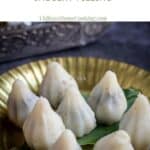
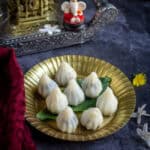

Leave a Reply